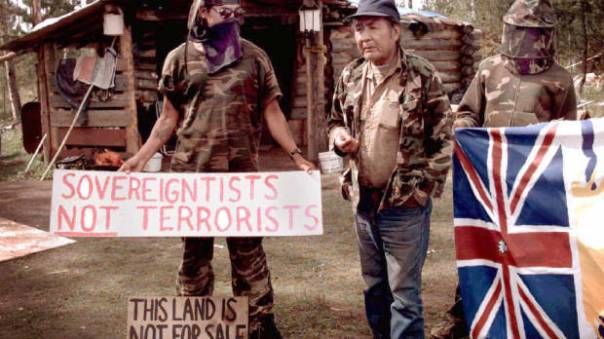Blog Archives
“Native 9/11” – Inquiry demanded into siege at Gustafsen Lake

Flora Samson, Ts’peten Defender, with granddaughter Kanahus. Photo: Vancouver Media Coop.
21 years later, Canada evades the legal, jurisdictional issues they tried to kill along with Secwepemc leaders.
Over a hundred people gathered during the afternoon of September 11, 2016, to remember what happened at Ts’peten (“Gustafsen Lake”) on that date in 1995. On that date, more than a dozen Secwepemc sovereigntists were trapped inside a barricade of 400 Royal Canadian Mounted Police – cut off from roads, radio and satellite phone – at the site of their recent Sundance. A formal inquiry has been demanded ever since. Read the rest of this entry
Meet the Man Who Fled Canada and Was Granted Asylum in the US

James “OJ” Pitawanakwat
By Sarah Berman, Vice.com, April 17, 2016
James “OJ” Pitawanakwat hasn’t returned to the Anishinaabe community on Manitoulin Island where he grew up in nearly two decades. He can’t, because in Canada there’s an outstanding warrant for his arrest.
Over the phone from his home on Saginaw Chippewa reservation in Michigan, Pitawanakwat tells me he feels a swell of pride thinking about the actions he took in the summer of 1995—actions that led to his arrest and conviction on mischief and weapons charges. Read the rest of this entry
Secwepemc Elder ‘Wolverine’ Ignace, 84, died Tuesday surrounded by family on home territory

Secwepemc elder Wolverine.
by Jorge Barrera, APTN National News, March 23, 2016
Secwepemc Elder William Jones “Wolverine” Ignace, who gained international recognition after the 1995 Gustafsen Lake standoff, died early Tuesday evening surrounded by family in his Adams Lake Indian Band home on Secwepemc territory.
He was 84, said his widow Flora Sampson.
Sampson said in an interview Wednesday that Jones, who is known as Wolverine, was suffering from cancer and had been seriously ill since December. Read the rest of this entry
Wolverine Speaks: Ts’Peten/Gustafsen Lake Inquiry, Genocide and Unceded Territories

Photo of Wolverine taken in the fall of 2014 at the Red Chris Mine road while it was being blockaded a second time after the Imperial Metals Mount Polley Disaster, August, 2014.
Published by: Ts’Peten Defence Committee, January 27, 2016
In her first public appearance as Federal Minister of Justice and Attorney General of
Canada, Jody Wilson-Raybould, Kwakwaka’wakw, publicly spoke to the letter I sent on
January 4th, 2016 to both her and the Prime Minister of Canada Justin Trudeau calling
for a National Inquiry into the Ts’Peten/Gustafsen Lake Standoff 1995. She was asked
three times by three women, to take action, to call this Inquiry and to address the
ongoing genocide that is taking place on our Territories. Her response, as the Federal
Minister of Justice and Attorney General of Canada was disrespectful and dismissive.
You all need a history lesson. Here it is. Read the rest of this entry
Gustafsen Lake warrior granted political asylum in US wants return home to Canada

James Pitawanakwat during the 1995 siege at Ts’Peten/Gustafsen Lake, BC.
by Jorge Barrera, APTN National News, January 15, 2016
A Wikwemikong man who was given political asylum in the U.S. following the 1995 Gustafsen Lake armed standoff in British Columbia wants to return to Canada.
James “OJ” Pitawanakwat, 44, has lived in the U.S. since August 1998 when he crossed the border while on day parole in Canada.
The U.S. Federal Court for the District of Oregon denied Canada’s extradition request for Pitawanakwat in November 2000 on grounds his actions in B.C. were “of a political character” and qualified for an exemption under the extradition treaty between Canada and the U.S. Read the rest of this entry
Secwepemc elder Wolverine calls for inquiry into 1995 Ts’Peten Standoff

Ts’Peten siege, 1995. Secwepemc elder Wolverine in centre.
This letter by Wolverine is being sent to the Government today. He is calling for a national public inquiry into Gustafsen Lake. Please share his letter to the Government of Canada calling for a public inquiry.
Under Liberal Prime Minister Jean Chrétien, Canada’s largest paramilitary operation was carried out on the sacred Sundance lands at Ts’Peten in 1995. Armoured personnel carriers, .50 calibre machine guns, land mines, and an astonishing 77,000 rounds of ammunition were directed at the land defenders. A police note by Chief Superintendent Johnston stated: “There are 6 hardliners in the camp WHO WILL REQUIRE KILLING.”
Ts’Peten, 1995
WarriorPublications.worpress.com
“We cannot call ourselves a nation if we don’t want to defend what is rightfully ours.”
Wolverine, Defenders of the Land, 1995
Introduction
In the summer of 1995, a month-long standoff occurred between Indigenous peoples & police near 100 Mile House, in the southern-interior region of British Columbia (BC). This land is the ancestral homeland of the Secwepemc (Shuswap).
Altogether, over 450 heavily-armed officers from various RCMP Emergency Response Teams (ERT), with military assistance, including 9 armoured personnel carriers, were deployed against some 24 defenders of a Sundance camp. In the end, it would be the largest RCMP paramilitary operation in Canadian history, costing over $5 million. Nearly half of this, $2.3 million, was for RCMP overtime. Read the rest of this entry
 Graphic History Collective Poster Series
Graphic History Collective Poster Series

